Monday, November 28, 2005
AUTUMN LEAVES
This weekend I spent some time at Josei Koen with my new digital camera. The weather was partly cloudy, so it was a good chance to practice photo-taking in different sunlight conditions. (Click photos to enlarge.)
Ginkgo leaves at suberiyama (part of Kochi castle) was just breathtaking. Good thing that those are fruitless type…otherwise the whole place would smell like hell in early autumn.
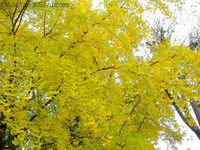
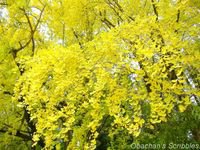
All the pics below are from one maple tree in Josei Koen. Though the tree is rather small, color tones of the leaves are just gorgeous.
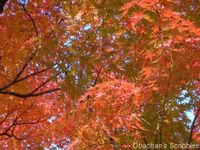

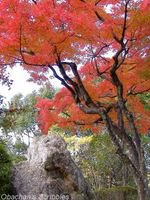
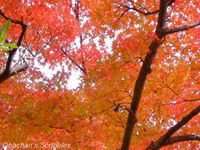
Actually it’s easier to take shots of maple leaves here than at Kochi castle. There are a lot more maple trees at the castle, but they are all very tall so you can’t really get close to the leaves. Besides, because of many tall trees, you have to be in a shade most of the time when taking photos.
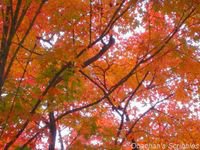
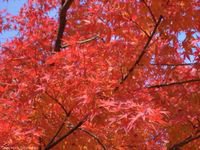

There is no doubt that this maple tree is everyone’s favorite. While I was taking photos, several people came to take photos like me or to sit under the tree to rest.
* See flickr badge on the sidebar for more photos of autumn leaves.
Ginkgo leaves at suberiyama (part of Kochi castle) was just breathtaking. Good thing that those are fruitless type…otherwise the whole place would smell like hell in early autumn.


All the pics below are from one maple tree in Josei Koen. Though the tree is rather small, color tones of the leaves are just gorgeous.




Actually it’s easier to take shots of maple leaves here than at Kochi castle. There are a lot more maple trees at the castle, but they are all very tall so you can’t really get close to the leaves. Besides, because of many tall trees, you have to be in a shade most of the time when taking photos.



There is no doubt that this maple tree is everyone’s favorite. While I was taking photos, several people came to take photos like me or to sit under the tree to rest.
* See flickr badge on the sidebar for more photos of autumn leaves.
Sunday, November 27, 2005
DAIKOKU-SAMA FESTIVAL IN INO
November 23, 2005
 Sugimoto Shine is located in a small town called Ino, which is about 20 minutes by car from Kochi city. The name Sugi (cedar) -moto is said to be related to the cedar tree that had something to do with the foundation of the shrine or the person who played a key role in that. Anyway, there enshrined are three gods including Ookuninushi no mikoto, commonly called Daikoku-san, who is said to have made the island of Japan, according to the Shinto legend.
Sugimoto Shine is located in a small town called Ino, which is about 20 minutes by car from Kochi city. The name Sugi (cedar) -moto is said to be related to the cedar tree that had something to do with the foundation of the shrine or the person who played a key role in that. Anyway, there enshrined are three gods including Ookuninushi no mikoto, commonly called Daikoku-san, who is said to have made the island of Japan, according to the Shinto legend.
Gods at this shrine are believed to give people prosperity, bumper crops, good marriage and family wealth, etc. and two big festivals are held there every year, one in spring and the other in autumn. Last Wednesday, Novermber 23rd, was the day for the autumn Daikoku-sama festival, and I really enjoyed it.
On that day, the gods at the shrine take a short trip to nearby riverbank. The object of the worship is carried in traditional mikoshi or miniature shrine, and local people dress up in ancient costumes and accompany the gods’ excursion. Gods’ short trip like this is called onabare in Kochi (I don’t remember hearing this word in my hometown, though). On the riverbank, people entertain god(s) with traditional dances.
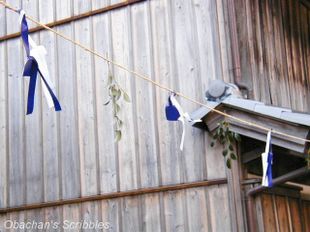 It was such a fine autumn day and the weather was absolutely perfect. I arrived at Ino town around noon. The road leading to the shrine was decorated with shimenawa. This rope tells that this is a sacred area where god-related events take place. I know those small branches are supposed to chase the evils away, but not sure why the color of the paper strips need to be white and purple. (Maybe related to ying-yang?)
It was such a fine autumn day and the weather was absolutely perfect. I arrived at Ino town around noon. The road leading to the shrine was decorated with shimenawa. This rope tells that this is a sacred area where god-related events take place. I know those small branches are supposed to chase the evils away, but not sure why the color of the paper strips need to be white and purple. (Maybe related to ying-yang?)
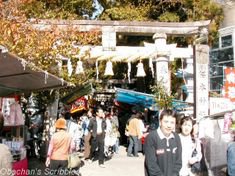 This shrine is said to be more than 1000 years old.
This shrine is said to be more than 1000 years old.
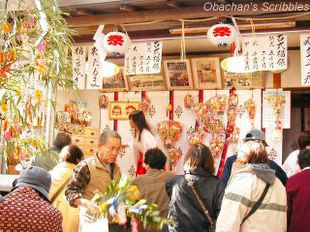
Lucky charms sold at the shrine (click to enlarge)
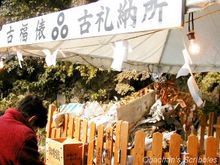 You can keep the decorated bamboo grass at home and return it here when it became old and turned brown.“Three circles" on this bannerr seems to be the symbol of this shrine ( maybe meaning three gods??) ; I saw it on almost everything there.
You can keep the decorated bamboo grass at home and return it here when it became old and turned brown.“Three circles" on this bannerr seems to be the symbol of this shrine ( maybe meaning three gods??) ; I saw it on almost everything there.
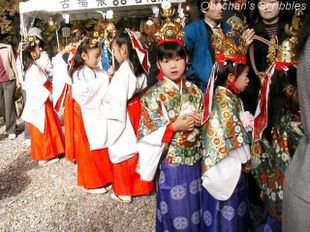
Kids waiting inside the shrine before onabare (click to enlarge)
At 13:00, onabare left the shrine and I walked through the town with this traditional parade.
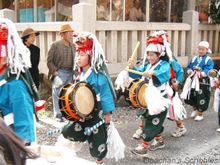
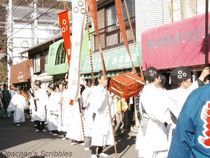

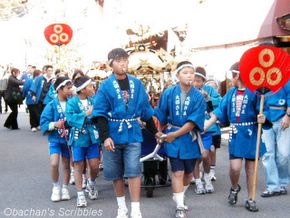
Mikoshi carried by boys

Mikoshi carried by girls
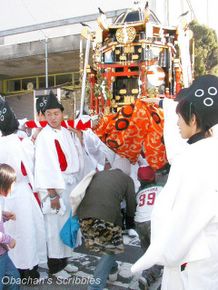 Sugimoto Shrine's lacquer-coated mikoshi (miniature shrine) is said to have been made about 700 years ago and designated as a national important cultural asset. I heard that the one they actually carry around in onabare parade (see photo) is a replica, which makes sense. They say that you can stay healthy if you go under the mikoshi during onabare, so they had to stop many times to let people pass under the miniature shrine.
Sugimoto Shrine's lacquer-coated mikoshi (miniature shrine) is said to have been made about 700 years ago and designated as a national important cultural asset. I heard that the one they actually carry around in onabare parade (see photo) is a replica, which makes sense. They say that you can stay healthy if you go under the mikoshi during onabare, so they had to stop many times to let people pass under the miniature shrine.
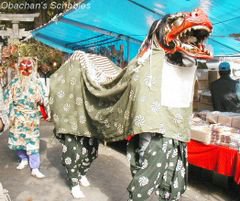 If you would go through the town with obanare, you'd probably wonder why you keep hearing small kids crying so hard here and there. Well, it’s because of this traditional custom. It is said that kids who had their heads bitten by this lion will grow smart and healthy. (Western psychologists would probably worry about the effect of this traumatic experience in early childhood.)
If you would go through the town with obanare, you'd probably wonder why you keep hearing small kids crying so hard here and there. Well, it’s because of this traditional custom. It is said that kids who had their heads bitten by this lion will grow smart and healthy. (Western psychologists would probably worry about the effect of this traumatic experience in early childhood.)
 Sure she doesn't look happy.
Sure she doesn't look happy.
* The lion just pretends to bite kids. It never actually hurts kids' heads.
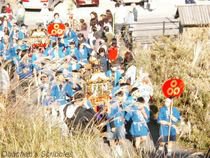

Onabare going up to the riverbank.
On the riverbank, kids performed traditional dances to entertain god(s). The audience was told that they had practiced the dance since summer.
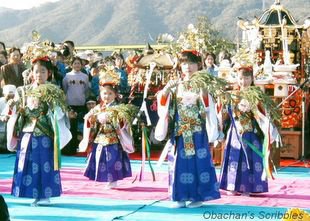
Girls' dance with cedar branches (click to enlarge)
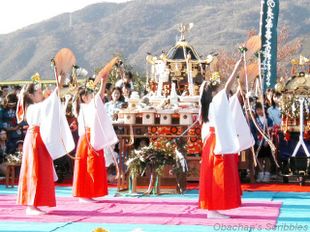
Fan dance (click to enlarge)

Bell dance
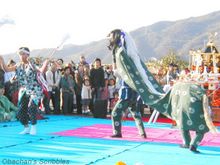
Traditional lion dance. This comical dance seems to be about a fight between a drunken man and a lion over a good-luck bamboo branch.
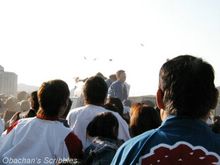 After the dance, rice cakes were thrown to onlookers. The rice cakes are associated with blessing of the god(s), so people really get enthusiastic to catch as many as possible. I was having a hard time trying to take some shots with my stupid old digital camera, so I couldn’t get any rice cakes!! It was my very first time since my childhood that I got none in this kind of rice-cake throwing ceremony! (Honestly that was part of the reason why I bought a new digital camera -- I was too mad!)
After the dance, rice cakes were thrown to onlookers. The rice cakes are associated with blessing of the god(s), so people really get enthusiastic to catch as many as possible. I was having a hard time trying to take some shots with my stupid old digital camera, so I couldn’t get any rice cakes!! It was my very first time since my childhood that I got none in this kind of rice-cake throwing ceremony! (Honestly that was part of the reason why I bought a new digital camera -- I was too mad!)
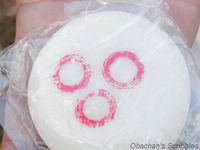
An old woman let me take a shot of the rice cake.
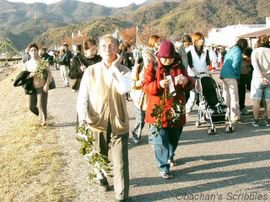
People going home with holly sakaki branches in hand, which, like the rice cakes, should give them good-luck.
Though I didn’t get a sakaki branch or rice cake, I believe that the photos I took there that day also "absorbed" gods’ blessing pretty much.
Hope these shots bring you a good luck, too. :)
 Sugimoto Shine is located in a small town called Ino, which is about 20 minutes by car from Kochi city. The name Sugi (cedar) -moto is said to be related to the cedar tree that had something to do with the foundation of the shrine or the person who played a key role in that. Anyway, there enshrined are three gods including Ookuninushi no mikoto, commonly called Daikoku-san, who is said to have made the island of Japan, according to the Shinto legend.
Sugimoto Shine is located in a small town called Ino, which is about 20 minutes by car from Kochi city. The name Sugi (cedar) -moto is said to be related to the cedar tree that had something to do with the foundation of the shrine or the person who played a key role in that. Anyway, there enshrined are three gods including Ookuninushi no mikoto, commonly called Daikoku-san, who is said to have made the island of Japan, according to the Shinto legend.Gods at this shrine are believed to give people prosperity, bumper crops, good marriage and family wealth, etc. and two big festivals are held there every year, one in spring and the other in autumn. Last Wednesday, Novermber 23rd, was the day for the autumn Daikoku-sama festival, and I really enjoyed it.
On that day, the gods at the shrine take a short trip to nearby riverbank. The object of the worship is carried in traditional mikoshi or miniature shrine, and local people dress up in ancient costumes and accompany the gods’ excursion. Gods’ short trip like this is called onabare in Kochi (I don’t remember hearing this word in my hometown, though). On the riverbank, people entertain god(s) with traditional dances.
 It was such a fine autumn day and the weather was absolutely perfect. I arrived at Ino town around noon. The road leading to the shrine was decorated with shimenawa. This rope tells that this is a sacred area where god-related events take place. I know those small branches are supposed to chase the evils away, but not sure why the color of the paper strips need to be white and purple. (Maybe related to ying-yang?)
It was such a fine autumn day and the weather was absolutely perfect. I arrived at Ino town around noon. The road leading to the shrine was decorated with shimenawa. This rope tells that this is a sacred area where god-related events take place. I know those small branches are supposed to chase the evils away, but not sure why the color of the paper strips need to be white and purple. (Maybe related to ying-yang?) This shrine is said to be more than 1000 years old.
This shrine is said to be more than 1000 years old.
Lucky charms sold at the shrine (click to enlarge)
 You can keep the decorated bamboo grass at home and return it here when it became old and turned brown.“Three circles" on this bannerr seems to be the symbol of this shrine ( maybe meaning three gods??) ; I saw it on almost everything there.
You can keep the decorated bamboo grass at home and return it here when it became old and turned brown.“Three circles" on this bannerr seems to be the symbol of this shrine ( maybe meaning three gods??) ; I saw it on almost everything there.
Kids waiting inside the shrine before onabare (click to enlarge)
At 13:00, onabare left the shrine and I walked through the town with this traditional parade.




Mikoshi carried by boys

Mikoshi carried by girls
 Sugimoto Shrine's lacquer-coated mikoshi (miniature shrine) is said to have been made about 700 years ago and designated as a national important cultural asset. I heard that the one they actually carry around in onabare parade (see photo) is a replica, which makes sense. They say that you can stay healthy if you go under the mikoshi during onabare, so they had to stop many times to let people pass under the miniature shrine.
Sugimoto Shrine's lacquer-coated mikoshi (miniature shrine) is said to have been made about 700 years ago and designated as a national important cultural asset. I heard that the one they actually carry around in onabare parade (see photo) is a replica, which makes sense. They say that you can stay healthy if you go under the mikoshi during onabare, so they had to stop many times to let people pass under the miniature shrine. If you would go through the town with obanare, you'd probably wonder why you keep hearing small kids crying so hard here and there. Well, it’s because of this traditional custom. It is said that kids who had their heads bitten by this lion will grow smart and healthy. (Western psychologists would probably worry about the effect of this traumatic experience in early childhood.)
If you would go through the town with obanare, you'd probably wonder why you keep hearing small kids crying so hard here and there. Well, it’s because of this traditional custom. It is said that kids who had their heads bitten by this lion will grow smart and healthy. (Western psychologists would probably worry about the effect of this traumatic experience in early childhood.) Sure she doesn't look happy.
Sure she doesn't look happy.* The lion just pretends to bite kids. It never actually hurts kids' heads.


Onabare going up to the riverbank.
On the riverbank, kids performed traditional dances to entertain god(s). The audience was told that they had practiced the dance since summer.

Girls' dance with cedar branches (click to enlarge)

Fan dance (click to enlarge)

Bell dance

Traditional lion dance. This comical dance seems to be about a fight between a drunken man and a lion over a good-luck bamboo branch.
 After the dance, rice cakes were thrown to onlookers. The rice cakes are associated with blessing of the god(s), so people really get enthusiastic to catch as many as possible. I was having a hard time trying to take some shots with my stupid old digital camera, so I couldn’t get any rice cakes!! It was my very first time since my childhood that I got none in this kind of rice-cake throwing ceremony! (Honestly that was part of the reason why I bought a new digital camera -- I was too mad!)
After the dance, rice cakes were thrown to onlookers. The rice cakes are associated with blessing of the god(s), so people really get enthusiastic to catch as many as possible. I was having a hard time trying to take some shots with my stupid old digital camera, so I couldn’t get any rice cakes!! It was my very first time since my childhood that I got none in this kind of rice-cake throwing ceremony! (Honestly that was part of the reason why I bought a new digital camera -- I was too mad!)
An old woman let me take a shot of the rice cake.

People going home with holly sakaki branches in hand, which, like the rice cakes, should give them good-luck.
Though I didn’t get a sakaki branch or rice cake, I believe that the photos I took there that day also "absorbed" gods’ blessing pretty much.
Hope these shots bring you a good luck, too. :)
Saturday, November 26, 2005
GUESS WHO I SAW ...
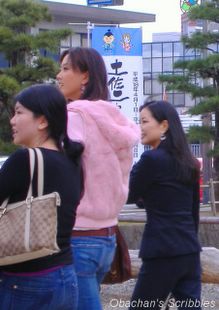 … at Kochi castle about a few hours ago. Michelle Wie! She is in Kochi now for Casio World Open Golf Tournament, but I never expected to see her there today!
… at Kochi castle about a few hours ago. Michelle Wie! She is in Kochi now for Casio World Open Golf Tournament, but I never expected to see her there today!I was there to take some shots of the castle gate with autumn leaves, then a few photographers came out from the main gate of the castle. They were obviously waiting for someone, and soon Michelle came out with a few young women and more photographers!

This girl talked to Michelle briefly (and maybe shook hands?) She was very nice to the kid.
Sweet girl :)
Wednesday, November 23, 2005
Brewery Tour at Takagi-Shuzo
November 20, 2005
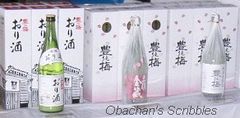 It was a real eye-opening day for me. I went to a town named Akaoka with a friend of mine to visit a local sake brewery. I had been to Akaoka once before in summer to see a famous “sake-drinking festival,” but I didn’t know much about the town itself or other attractions there. One of the new findings that day was this: As of November 2005, Akaoka is officially “the smallest town in Japan (area-wise).” It has been ranked as the smallest since the beginning of this year because the ex-smallest town in Nagasaki pref. merged into a bigger city then.
It was a real eye-opening day for me. I went to a town named Akaoka with a friend of mine to visit a local sake brewery. I had been to Akaoka once before in summer to see a famous “sake-drinking festival,” but I didn’t know much about the town itself or other attractions there. One of the new findings that day was this: As of November 2005, Akaoka is officially “the smallest town in Japan (area-wise).” It has been ranked as the smallest since the beginning of this year because the ex-smallest town in Nagasaki pref. merged into a bigger city then.
Why did I decide to visit a sake brewery there? Well, for the past couple of months, I’ve been doing a little net search for my foodblog entries on fermented foods such as miso and soy sauce, and in doing so, my interest was gradually directed to our No.1 local product, sake. Yes, for us, Kochi is not Kochi without sake. And when I found out about the “brewery tour” at several sake breweries in Kochi, my curiosity drove me to go for it. I picked this small brewery, Takagi Shuzo (Brewery) in Akaoka, because its location was convenient for me and my friend, and sake-tasting was included in the tour ;)
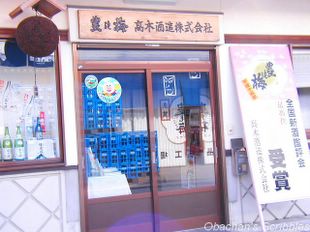
At the brewery, young president, Mr. Takagi welcomed us (with his right arm in plaster! ) and gave us a tour. First he showed us several kinds of rice used for sake-making.
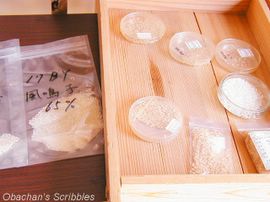
He told us that good sake rice has larger kernel, shinpaku (high starch concentration in the core) and softer texture that allows the milling to sometimes less than 50% of the original grain. The more polished, the better the quality and fragrance will be. Sake made from the rice that were milled to 60% or less of the original size is called ginjo-shu. Now I understand why the premium sake, daiginjo, is such a luxury-- more than half of the rice grain is milled away!! In addition to the ever famous sake rice, “Yamada nishiki,” there were also samples of Kochi-grown sake rice. We also learned about the different types of sake and the process of sake-making.
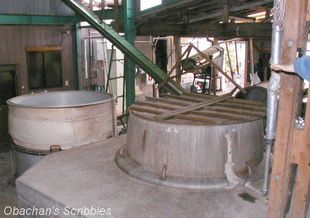 This is the big steamer they use for steaming sake rice. Mr. Takagi said that only steaming can prepare rice properly for koji rice mold making; boiling or roasting does not work.
This is the big steamer they use for steaming sake rice. Mr. Takagi said that only steaming can prepare rice properly for koji rice mold making; boiling or roasting does not work.
 Now, the first big eye-opener was what I learned about yeast and the fragrance. Before that, I didn’t believe that sake had a “fruity" fragrance, because I never had a chance to drink expensive kind, ginjo-shu, which is said to have such fragrance. Sake is made from rice, not fruits. So I thought the word “fruity” was some kind of metaphor, an expression borrowed from wine-making or something. WRONG! For the first time I learned that esters produced by yeast have real banana- or melon- or apple-like aroma, and they give sake literally “fruity” fragrance.
Now, the first big eye-opener was what I learned about yeast and the fragrance. Before that, I didn’t believe that sake had a “fruity" fragrance, because I never had a chance to drink expensive kind, ginjo-shu, which is said to have such fragrance. Sake is made from rice, not fruits. So I thought the word “fruity” was some kind of metaphor, an expression borrowed from wine-making or something. WRONG! For the first time I learned that esters produced by yeast have real banana- or melon- or apple-like aroma, and they give sake literally “fruity” fragrance.
Another thing I learned that day was the meaning of the measurement called shudo酒度 or nihonshu-do日本酒度, which is an indicator of how sweet/dry the sake is (and technically the specific gravity of sake). The larger number of shudo with “+ (plus)” means less sugar content (and more alcohol?) as a result of longer fermentation, thus a dryer taste. The larger shudo with “- (minus)“ means more sugar content from a shorter fermentation, thus a sweeter taste.
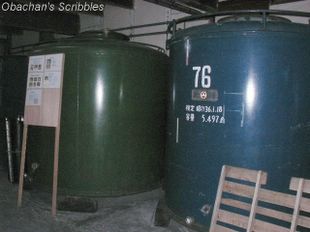 I think these tanks were the ones we saw in the Shikomi-room (fermentation room?), IIRC. There, more rice, koji and water are added to the starter in 3 times and the fermentation takes place to form the mash called moromi. (That reminded me of feeding my sourdough starter.) He also told us about pasteurization, and said that Japanese brewers were already doing a similar thing in sake-production way before Pasteur started pasteurization.
I think these tanks were the ones we saw in the Shikomi-room (fermentation room?), IIRC. There, more rice, koji and water are added to the starter in 3 times and the fermentation takes place to form the mash called moromi. (That reminded me of feeding my sourdough starter.) He also told us about pasteurization, and said that Japanese brewers were already doing a similar thing in sake-production way before Pasteur started pasteurization.
 This compressor(?) is used to press sake out from moromi mash. Mr. Takagi also told us about the extraction method that uses bags and allows sake to drip out -- the method used to make their best-quality sake for contests. At this point I wasn’t really convinced that the different extraction methods would make such a great difference in the flavor of the final products.
This compressor(?) is used to press sake out from moromi mash. Mr. Takagi also told us about the extraction method that uses bags and allows sake to drip out -- the method used to make their best-quality sake for contests. At this point I wasn’t really convinced that the different extraction methods would make such a great difference in the flavor of the final products.
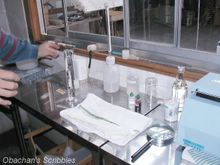 He also took us to a small room and showed us the equipments used for measuring the specific gravity. He said that acidity and amino-acid content are also measured there.
He also took us to a small room and showed us the equipments used for measuring the specific gravity. He said that acidity and amino-acid content are also measured there.
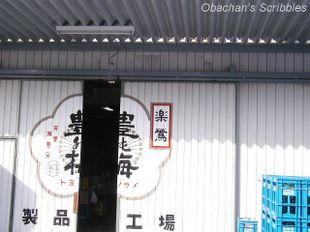
After the tour, Mr. Takagi took us to a storage room. It was finally the moment I’d been waiting for… time for tasting sake! And what I experienced there completely changed my view on sake. Details are here on my foodblog :)
----
 Mr. Takagi brought us back to the office after the sake-tasting and showed us some other materials including the photos of the tornados that hit Kochi in 1994. He said one of them came above this brewery and disappeared, causing no damage to the facility.
Mr. Takagi brought us back to the office after the sake-tasting and showed us some other materials including the photos of the tornados that hit Kochi in 1994. He said one of them came above this brewery and disappeared, causing no damage to the facility.
I also asked him about the “space sake” project that I read on the paper the other day. He said many breweries in Kochi are involved in the project and they will all use the rice and yeast that came back from the space but each brewery would choose a production method (such as how much to mill the rice and how to extract, etc.) that they like. The final products will be categorized as “Tosa uchu-shu (Tosa space sake)” and each brewery will give their product whatever name they like, and according to the brewing method chosen, the price would vary. One of the only two master brewers in Kochi works there at Takagi brewery, so I believe their uchu-shu will be an excellent one.
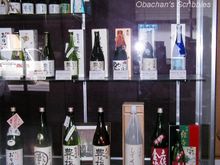 Before attending the tour, I did a little net search to learn the basics of sake-making and English terms, because I thought my friend might like some explanations in English. The website that was most helpful to me was this, and the moment I told Mr. Takagi about the site, he immediately said “Is that John Gauntner's site ?” He said Mr. Gauntner was a leading authority of sake outside Japan.
Before attending the tour, I did a little net search to learn the basics of sake-making and English terms, because I thought my friend might like some explanations in English. The website that was most helpful to me was this, and the moment I told Mr. Takagi about the site, he immediately said “Is that John Gauntner's site ?” He said Mr. Gauntner was a leading authority of sake outside Japan.
During the tour, Mr. Takagi helped me with some English terms, so I assumed that he had a fairly good English skill. When I asked if he would give a tour in English, he said he would need to mix English and Japanese sometimes. With the English panphlet they have there, I think it's possible for a non-Japanese speaker to get the basic idea of sake-making and enjoy the tour at this brewery.
It was such an eye-opening, interesting experience that introduced me to a new interest. Now I’m so tempted to try many different kinds of sake and find my "most favorite,” and try various combinations with appetizers/meals. :)
Takagi Shuzo
http://www.toyonoume.com/
(Japanese only)
 It was a real eye-opening day for me. I went to a town named Akaoka with a friend of mine to visit a local sake brewery. I had been to Akaoka once before in summer to see a famous “sake-drinking festival,” but I didn’t know much about the town itself or other attractions there. One of the new findings that day was this: As of November 2005, Akaoka is officially “the smallest town in Japan (area-wise).” It has been ranked as the smallest since the beginning of this year because the ex-smallest town in Nagasaki pref. merged into a bigger city then.
It was a real eye-opening day for me. I went to a town named Akaoka with a friend of mine to visit a local sake brewery. I had been to Akaoka once before in summer to see a famous “sake-drinking festival,” but I didn’t know much about the town itself or other attractions there. One of the new findings that day was this: As of November 2005, Akaoka is officially “the smallest town in Japan (area-wise).” It has been ranked as the smallest since the beginning of this year because the ex-smallest town in Nagasaki pref. merged into a bigger city then.Why did I decide to visit a sake brewery there? Well, for the past couple of months, I’ve been doing a little net search for my foodblog entries on fermented foods such as miso and soy sauce, and in doing so, my interest was gradually directed to our No.1 local product, sake. Yes, for us, Kochi is not Kochi without sake. And when I found out about the “brewery tour” at several sake breweries in Kochi, my curiosity drove me to go for it. I picked this small brewery, Takagi Shuzo (Brewery) in Akaoka, because its location was convenient for me and my friend, and sake-tasting was included in the tour ;)

At the brewery, young president, Mr. Takagi welcomed us (with his right arm in plaster! ) and gave us a tour. First he showed us several kinds of rice used for sake-making.

He told us that good sake rice has larger kernel, shinpaku (high starch concentration in the core) and softer texture that allows the milling to sometimes less than 50% of the original grain. The more polished, the better the quality and fragrance will be. Sake made from the rice that were milled to 60% or less of the original size is called ginjo-shu. Now I understand why the premium sake, daiginjo, is such a luxury-- more than half of the rice grain is milled away!! In addition to the ever famous sake rice, “Yamada nishiki,” there were also samples of Kochi-grown sake rice. We also learned about the different types of sake and the process of sake-making.
 This is the big steamer they use for steaming sake rice. Mr. Takagi said that only steaming can prepare rice properly for koji rice mold making; boiling or roasting does not work.
This is the big steamer they use for steaming sake rice. Mr. Takagi said that only steaming can prepare rice properly for koji rice mold making; boiling or roasting does not work. Now, the first big eye-opener was what I learned about yeast and the fragrance. Before that, I didn’t believe that sake had a “fruity" fragrance, because I never had a chance to drink expensive kind, ginjo-shu, which is said to have such fragrance. Sake is made from rice, not fruits. So I thought the word “fruity” was some kind of metaphor, an expression borrowed from wine-making or something. WRONG! For the first time I learned that esters produced by yeast have real banana- or melon- or apple-like aroma, and they give sake literally “fruity” fragrance.
Now, the first big eye-opener was what I learned about yeast and the fragrance. Before that, I didn’t believe that sake had a “fruity" fragrance, because I never had a chance to drink expensive kind, ginjo-shu, which is said to have such fragrance. Sake is made from rice, not fruits. So I thought the word “fruity” was some kind of metaphor, an expression borrowed from wine-making or something. WRONG! For the first time I learned that esters produced by yeast have real banana- or melon- or apple-like aroma, and they give sake literally “fruity” fragrance.Another thing I learned that day was the meaning of the measurement called shudo酒度 or nihonshu-do日本酒度, which is an indicator of how sweet/dry the sake is (and technically the specific gravity of sake). The larger number of shudo with “+ (plus)” means less sugar content (and more alcohol?) as a result of longer fermentation, thus a dryer taste. The larger shudo with “- (minus)“ means more sugar content from a shorter fermentation, thus a sweeter taste.
 I think these tanks were the ones we saw in the Shikomi-room (fermentation room?), IIRC. There, more rice, koji and water are added to the starter in 3 times and the fermentation takes place to form the mash called moromi. (That reminded me of feeding my sourdough starter.) He also told us about pasteurization, and said that Japanese brewers were already doing a similar thing in sake-production way before Pasteur started pasteurization.
I think these tanks were the ones we saw in the Shikomi-room (fermentation room?), IIRC. There, more rice, koji and water are added to the starter in 3 times and the fermentation takes place to form the mash called moromi. (That reminded me of feeding my sourdough starter.) He also told us about pasteurization, and said that Japanese brewers were already doing a similar thing in sake-production way before Pasteur started pasteurization. This compressor(?) is used to press sake out from moromi mash. Mr. Takagi also told us about the extraction method that uses bags and allows sake to drip out -- the method used to make their best-quality sake for contests. At this point I wasn’t really convinced that the different extraction methods would make such a great difference in the flavor of the final products.
This compressor(?) is used to press sake out from moromi mash. Mr. Takagi also told us about the extraction method that uses bags and allows sake to drip out -- the method used to make their best-quality sake for contests. At this point I wasn’t really convinced that the different extraction methods would make such a great difference in the flavor of the final products. He also took us to a small room and showed us the equipments used for measuring the specific gravity. He said that acidity and amino-acid content are also measured there.
He also took us to a small room and showed us the equipments used for measuring the specific gravity. He said that acidity and amino-acid content are also measured there.
After the tour, Mr. Takagi took us to a storage room. It was finally the moment I’d been waiting for… time for tasting sake! And what I experienced there completely changed my view on sake. Details are here on my foodblog :)
----
 Mr. Takagi brought us back to the office after the sake-tasting and showed us some other materials including the photos of the tornados that hit Kochi in 1994. He said one of them came above this brewery and disappeared, causing no damage to the facility.
Mr. Takagi brought us back to the office after the sake-tasting and showed us some other materials including the photos of the tornados that hit Kochi in 1994. He said one of them came above this brewery and disappeared, causing no damage to the facility.I also asked him about the “space sake” project that I read on the paper the other day. He said many breweries in Kochi are involved in the project and they will all use the rice and yeast that came back from the space but each brewery would choose a production method (such as how much to mill the rice and how to extract, etc.) that they like. The final products will be categorized as “Tosa uchu-shu (Tosa space sake)” and each brewery will give their product whatever name they like, and according to the brewing method chosen, the price would vary. One of the only two master brewers in Kochi works there at Takagi brewery, so I believe their uchu-shu will be an excellent one.
 Before attending the tour, I did a little net search to learn the basics of sake-making and English terms, because I thought my friend might like some explanations in English. The website that was most helpful to me was this, and the moment I told Mr. Takagi about the site, he immediately said “Is that John Gauntner's site ?” He said Mr. Gauntner was a leading authority of sake outside Japan.
Before attending the tour, I did a little net search to learn the basics of sake-making and English terms, because I thought my friend might like some explanations in English. The website that was most helpful to me was this, and the moment I told Mr. Takagi about the site, he immediately said “Is that John Gauntner's site ?” He said Mr. Gauntner was a leading authority of sake outside Japan.During the tour, Mr. Takagi helped me with some English terms, so I assumed that he had a fairly good English skill. When I asked if he would give a tour in English, he said he would need to mix English and Japanese sometimes. With the English panphlet they have there, I think it's possible for a non-Japanese speaker to get the basic idea of sake-making and enjoy the tour at this brewery.
It was such an eye-opening, interesting experience that introduced me to a new interest. Now I’m so tempted to try many different kinds of sake and find my "most favorite,” and try various combinations with appetizers/meals. :)
Takagi Shuzo
http://www.toyonoume.com/
(Japanese only)
Thursday, November 17, 2005
RYOMA FESTIVAL (NOV. 13, 2005)

Those who have been to Kochi have probably heard about Ryoma Sakamoto or at least have seen his name on souvenirs at most of sightseeing spots in Kochi. You might wonder what’s so great about that guy. In a nutshell, he is our local hero who played a key role in Meiji Restoration, a sort of coup d’etat(?) that ended the feudal era and lead Japan in the direction of modern democracy.
There's a good article about Ryoma Sakamoto that I found on the net. Just like many other “Ryoma fans” in Japan, my view on this guy is largely influenced by the popular novel “Ryoma ga yuku,” so I do not fully agree with this author’s view at some points. Nevertheless, I think this article gives a real good overview of his life and the time he lived, and I’m very grateful that someone outside Japan studied about a samurai from our prefecture this extensively and with this much respect.
To me Ryoma is more like a symbol of young energy, enthusiasm, open-mindedness, and love of dreams, freedom and adventure. In my view, he was like the Pacific Ocean when most other corrupted samurais (government bureaucrats) of that time were like cattle tanks. He is a symbol of the adoration for something beyond the horizon... adoration that we may have, or wish to be able to have again, in our real lives.
Anyway, people celebrate Ryoma Festival here in Kochi around November 15th, his birthday and also the day that he was assassinated. Today some events were held at Katsurahama beach near Ryoma’s statue, and the area near the parking lot was so crowded with cars from in and outside Kochi prefecture.
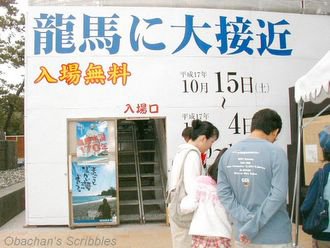
For certain period around his birthday, they set up a high, tower-like frame next to his statue and allow visitors to go up to view the Pacific Ocean from the same height as the statue. I found out about that last year when it was too late, so I was determined to give it a try this time.
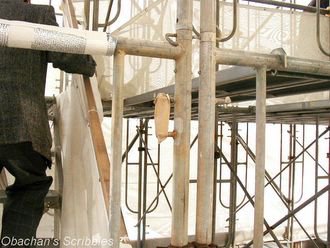 Climbing up the steps was a little scary experience. I’m not too afraid of height, but when I can see all the frames and joints this way, it was a different story. But finally I got to the top and took these shots. Because of the cloudy weather, the sky and the ocean didn’t look too great. What a shame.
Climbing up the steps was a little scary experience. I’m not too afraid of height, but when I can see all the frames and joints this way, it was a different story. But finally I got to the top and took these shots. Because of the cloudy weather, the sky and the ocean didn’t look too great. What a shame.
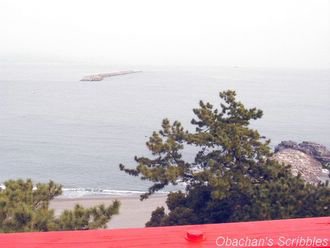
-----
There was a kendo (Japanese bamboo stick fencing) competition being held on the beach near the statue. Ryoma was a great swordmaster. They say that he practiced kendo very hard just like these kids.
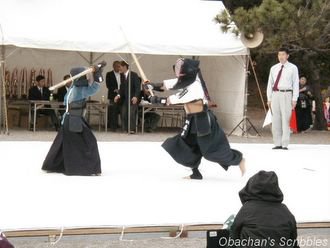
------
Our good old castnetting folks had an Okaami 陸網 (on-land cast-net throwing competition) there as a festival-related event. As I wrote in my previous post, this is the competition not of the number of fish you catch but of cast-net throwing skill. Among many members I haven't met before, I saw the friendly faces of those people who showed me the demonstrations and took me to the river the other day.


It was such a beautiful scene… colorful nets on the beach, green pine trees and the ocean… Too bad that it was cloudy that day and my camera couldn’t capture the beauty of the scenes very much.
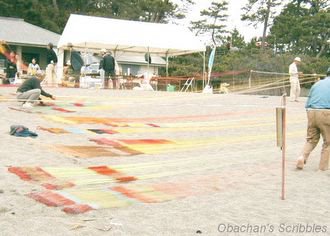
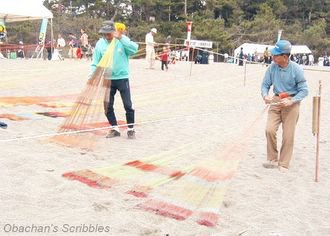

Some staff members were in happi coats that day, which looked very festive. As the net spread in the air, making a slight frictional noise, the audience exclaimed “OH!” “Beautiful!” “Good job!”



As the competition was going on, visitors (mainly kids) were encouraged to try castnetting. These nice people didn’t mind spending a long time teaching how to hold and throw the net to very young kids, including a 4 year-old boy.
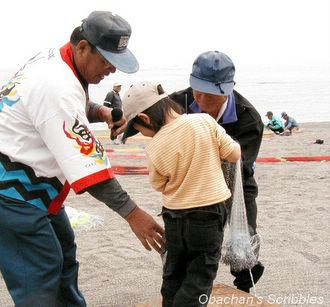
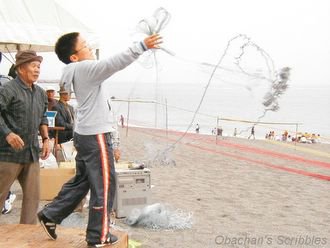
I was told that the competition that day was a sort of exhibition game and the participants' scores did not affect their official rankings.
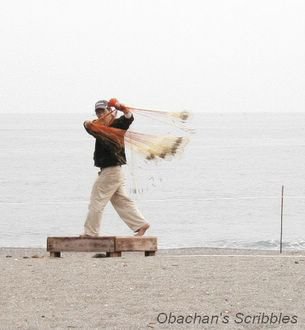

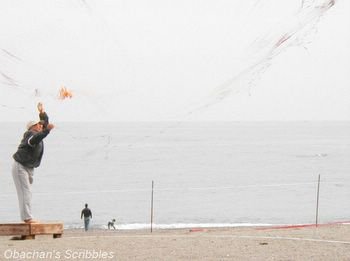
Mr. YS, the friendly guy who showed me a demonstration the other day, did really great that day and won two prizes. He looked so happy.
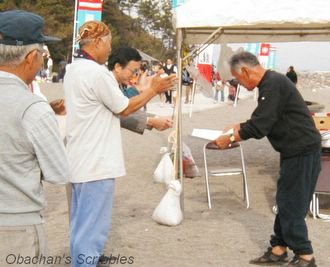
------
Meanwhile, a game show was going on at a main stage near the souvenir shops. Participants were Ryoma fans from all over Japan, I suppose. The game show hostess read Ryoma-related questions, and those who answered correctly were allowed to move closer to the stage, and those who got on the stage were given the prizes on the table. It was amazing that the participants knew so much about his life. I read “Ryoma ga yuku” more than twenty times but couldn't guess the answers for some questions. Those people (the winners) must be real fanatics. :)

------
Sightseeing at Katsurahana beach involves quite a bit of going up and down the steps/slopes, and I was already tired around 4pm. This was the shot I took right before leaving the beach.

The penguins looked as tired as I was, but they were still curious and trying to peck the kid's hand.
As I left the beach, I saw many cars still waiting in line to get in the parking lot, and I felt so sorry for those people in the car. When they got on the beach, maybe Ryoma's statue under the cloudy sky was the only thing there to welcome them. I hope they do something about the problem next year.
I wonder what Ryoma would say if he were alive now and saw this many fans wanting to get close to him at this festival. :)


